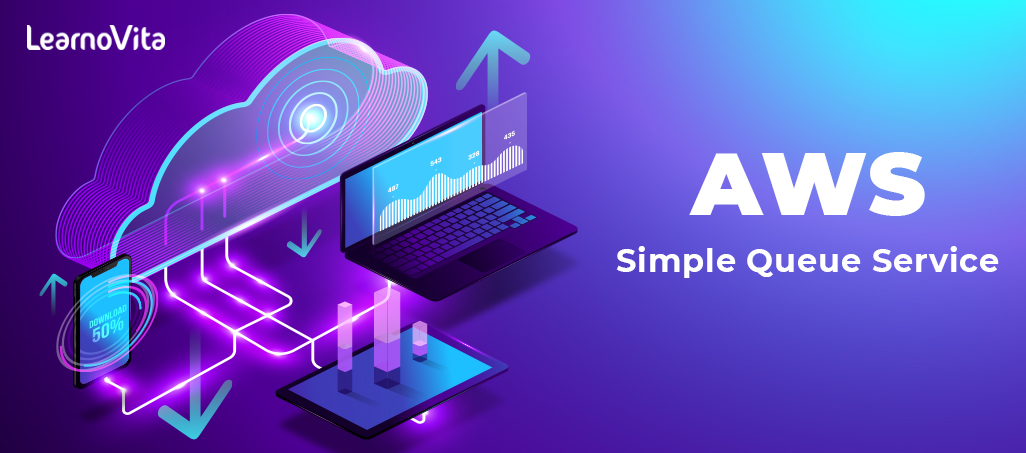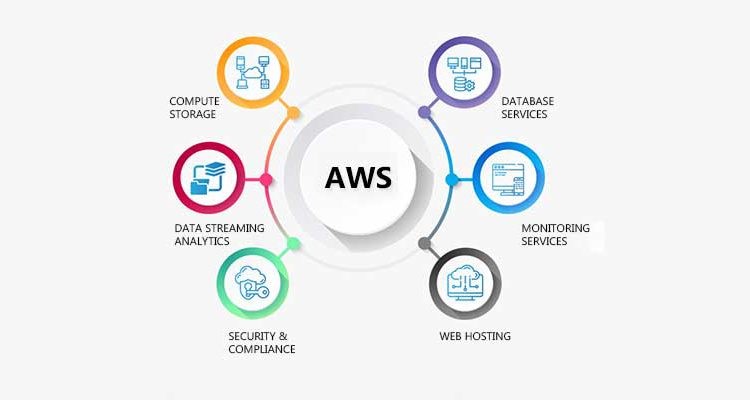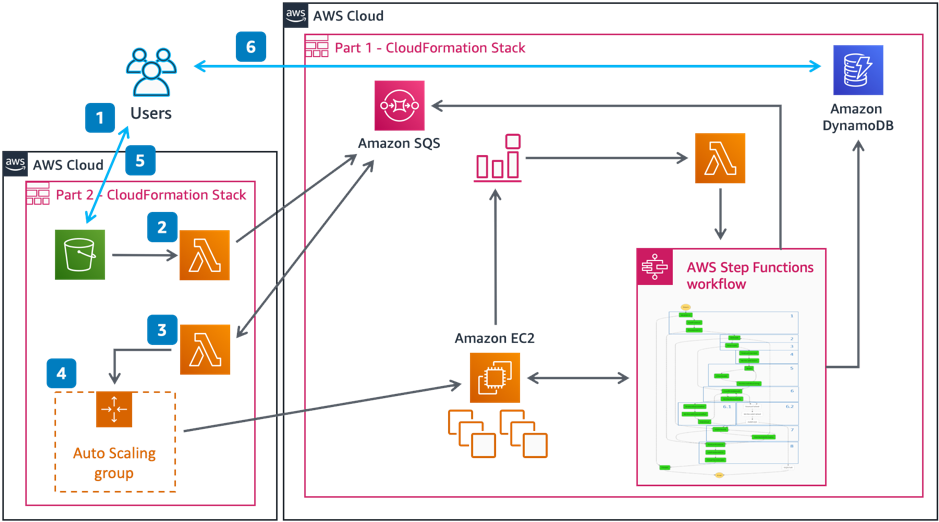
AWS SQS – Simple Queue Service Tutorial | Quickstart – MUST READ
Last updated on 10th Aug 2022, Blog, Tutorials
Introduction:
AWS tutorial provides basic and advanced ideas. Our AWS tutorial is meant for beginners and professionals.AWS stands for Amazon net Services that uses distributed IT infrastructure to produce totally different IT resources on demand.Our AWS tutorial includes all the topics like introduction, history of aws, world infrastructure, options of aws, IAM, Storage services, info services, etc.
Definiton:
AWS stands for Amazon net Services.
The AWS service is provided by the Amazon that uses distributed IT infrastructure to produce totally different IT resources out there on demand. It provides totally different services like infrastructure as a service (IaaS), platform as a service (PaaS) and prepacked computer code as a service (SaaS).
Amazon launched AWS, a cloud computing platform to permit the various organizations to require advantage of reliable IT infrastructure.
What is Amazon SQS?
- SQS stands for easy Simple Queue Service.
- SQS was the primary service obtainable in AWS.
- Amazon SQS could be a internet service that offers you access to a message queue which will be wont to store messages whereas anticipating a laptop to method them.
- Amazon SQS could be a distributed queue system that permits internet service applications to quickly and dependably queue messages that one part within the application generates to be consumed by another part wherever a queue could be a temporary repository for messages that ar awaiting process.
- With the assistance of SQS, you’ll be able to send, store and receive messages between software package elements at any volume while not losing.
- Using Amazon sqs, you’ll be able to separate the elements of associate application so they will run severally, easing message management between elements.
- Any part of a distributed application will store the messages within the queue.
- Messages will contain up to 256 K of text in any format like json, xml, etc..
- Any part of associate application will later retrieve the messages programmatically exploitation the Amazon SQS API.
- The queue acts as a buffer between the part manufacturing and saving information, and therefore the part receives the info for process. this suggests that the queue resolves problems that arise if the producer is manufacturing work quicker than the patron will method it, or if the producer or client is just intermittently connected to the network.
- If you bought 2 EC2 instances that pull the SQS Queue. you’ll be able to assemble the autoscaling cluster if variety of messages check a definite limit. Suppose the amount of messages exceeds ten, then you’ll be able to add extra EC2 instance to method the work quicker. during this approach, SQS provides snap.
Aspects of SQS
Any programme, app, or service can take advantage of SQS because it is a cloud-based service. SQS operates as a separate cloud service. A programme establishes a connection to SQS by providing authentication information and the names of the queues to which to send messages. Applications can use SQL to make and delete unique queues.Shipping Twice – At least one delivery is made for each queued message. Every single communication you send will reach its intended recipient.The queue can be shared by multiple parts. When one component is using a message, SQS locks it so that no other components can see it. Successfully processed messages are removed from the queue.
If there is an error when processing a message, it will remain in the queue where it can be seen by all of the parts. “Visibility Timeout” describes this function.Standard queues and First-in, First-out (FIFO) queues exist. Messages are selected at random in ordinary queue. While a FIFO queue guarantees that items will be processed in the order in which they were added to the queue, this may not always be the case.Dead-letter queue is where unprocessable messages are stored.The quantity of queued requests is used to compute the price. SQS is a useful service for improving the productivity, dependability, and performance of software programmes.
Advantages of AWS:
Flexibility:We will get longer for core business tasks because of the moment accessibility of latest options and services in AWS.It provides easy hosting of bequest applications. AWS doesn’t need learning new technologies and migration of applications to the AWS provides the advanced computing and economical storage AWS conjointly offers a alternative that whether or not we would like to run the applications and services along or not. we are able to conjointly prefer to run half of the IT infrastructure in AWS and therefore the remaining part in knowledge centres
Cost-effectiveness:AWS needs no direct investment, long-run commitment, and minimum expense compared to ancient IT infrastructure that needs a large investment.
Scalability:Through AWS, autoscaling and elastic load equalization techniques square measure mechanically scaled up or down, once demand will increase or decreases severally. AWS techniques square measure ideal for handling unpredictable or terribly high hundreds. because of this reason, organizations get pleasure from the advantages of reduced price and augmented user satisfaction.
Security:AWS provides end-to-end security and privacy to customers.AWS includes a virtual infrastructure that provides optimum accessibility whereas managing full privacy and isolation of their operations.Customers will expect high-level of physical security due to Amazon’s many years of expertise in planning, developing and maintaining large-scale IT operation centers.AWS ensures the 3 aspects of security, i.e., Confidentiality, integrity, and accessibility of user’s knowledge.

Disadvantages
Reduced Management service:What you’ll well find yourself having to try and do once running a message queue system on a scale is to fine-tune its output to suit your desires. this is often not a alternative with SQS: the service is totally controlled, and you don’t ought to look underneath the hood.
High value at scale:With pay per use rating, your SQS bill are often terribly giant if the quantity of messages you send is kind of high. information transfer charges area unit a part of SQS rating, and these will add up if you send giant messages, or if you method messages from outside the most AWS space wherever thequeue is found. In bound cases, the value of mistreatment SQS could also be beyond the value of operative your own queue system whereas running on a scale of innumerable messages handled on a daily basis, even with the overhead for maintaining your own resolution.
Lack of support for broadcast messages:SQS doesn’t settle for the way for multiple organizations to retrieve a similar message with its “exactly once” transmission, creating SQS not therefore effective for one-to-many broadcasts. to deal with this, developers will use SQS aboard SNS in cases wherever one-to-many delivery is important.
Benefits:
1.The low-overhead nature of SQS makes it a popular choice for deployment.
There is no initial investment or ongoing administrative fees associated with implementing SQS. Everything may be adjusted in the AWS cloud, and APIs are provided for automated queue management. You only pay for the resources you really use with AWS’s pay-as-you-go pricing approach.
2. SQL is dependable.
Sending large amounts of data at high throughput rates without missing messages or depending on other services is possible with Amazon Simple Queue Service (SQS). By allowing application components to run and fail independently, SQS improves the system’s fault tolerance. Every message is duplicated and stored in different availability zones in case one fails.
3.SQS provides safe storage.
Amazon Simple Message Service (SQS) supports server-side encryption (SSE) for secure data transfer between apps. AWS Key Management Service (KMS) integrates with Amazon Simple Queue Service (SQS) to provide for centralised management of encryption keys used to secure SQS communications and other AWS services. To aid in your compliance and regulatory requirements, AWS KMS records all key usage in AWS CloudTrail.
4.SQS is a cost-effective and scalable solution.
Amazon Simple Queue Service uses the AWS cloud to automatically expand or contract to meet peak loads. Instead of worrying about capacity planning and pre-provisioning, SQS scales elastically with your application. In addition to virtually infinite throughput, a standard queue also has no hard cap on the number of messages it can hold. The usage-based pricing approach offers significant savings over the “always-on” pricing structure of self-managed message middleware.
The Structural of Amazon’s Simple Queue Service
This section describes the various nodes in a distributed messaging system and walks you through an Amazon SQS message’s entire lifespan.
Linked queues:You can think of a distributed messaging system as consisting of three primary parts: your distributed system’s components, your queue (which is stored in multiple locations using Amazon SQS servers), and the messages themselves.You have a system with multiple producers (components that contribute messages to the queue) and consumers (components that receive those messages) (components that receive messages from the queue). Messages A through E are stored in a queue that is replicated across multiple Amazon SQS servers for redundancy.
The Cycle of a Message:The generation and eventual removal from a queue of an Amazon SQS message is depicted in the following example.Message A originates from a producer (part 1) and is replicated across multiple Amazon SQS servers for redundancy.Message A is returned after it has been consumed from the queue by a consumer (component 2). Message A stays in the queue for as long as the visibility timeout specifies while it’s being processed.In order to prevent message A from being re-received and re-processed after the visibility timeout has elapsed, the consumer (component 2) removes it from the queue.

Distinctions between Amazon Simple Queue Service, Amazon Message Queue, and Amazon Simple Notification Service
Amazon Simple Queue Service (SQS) and Simple Notification Service (SNS) are queue and topic services that are scalable, easy to use, and don’t need message brokers to function. If your new app can take use of practically infinite scalability and straightforward APIs, we suggest using these services.
Amazon MQ is a managed service that works with a wide variety of other message broker protocols. If your current message broker requires compatibility with APIs like JMS or protocols like AMQP, MQTT, OpenWire, and STOMP, then you should consider switching to Amazon MQ.
Features of Amazon SQS:
The Structural of Amazon’s Simple Queue Service
- Message and queue identifiers
- Data about data
- The needed message-handling resources
- Pagination in a list queue
- Identification labels for spending
- Measurement of public opinion throughout both short and extended time periods
- Lines of doom
- Hold for better visibility
- Waiting lines
- Holding areas
- Timer messages
Conclusion:
Manage your Amazon Simple Queue Service (Amazon SQS) queues and features through the Amazon SQS console. The interface is also where you can set up triggers to call an Amazon Lambda function, attach a dead-letter queue with your queue, and setup other features like server-side encryption.
Are you looking training with Right Jobs?
Contact Us- AWS Tutorial
- AWS iOT Tutorial
- AWS Amazon S3 Bucket Tutorial
- Top AWS Services
- AWS Lambda Tutorial | A Guide to Creating Your First Function
Related Articles
Popular Courses
- VM Ware Training
11025 Learners - Microsoft Dynamics Training
12022 Learners - Siebel Training
11141 Learners
- What is Dimension Reduction? | Know the techniques
- Difference between Data Lake vs Data Warehouse: A Complete Guide For Beginners with Best Practices
- What is Dimension Reduction? | Know the techniques
- What does the Yield keyword do and How to use Yield in python ? [ OverView ]
- Agile Sprint Planning | Everything You Need to Know
